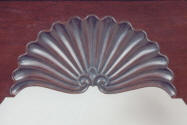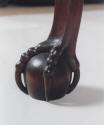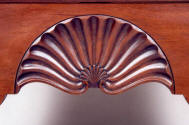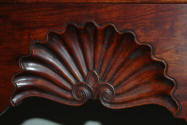John Townsend Bonnet-Top Highboy
with ball & claw front feet and shell
mahogany, 86"h, 40"w, 23"d
This is a highly evolved form of a John
Townsend highboy, representing the work of Townsend at his most mature
style. The ball and claw front feet are overcut with open talons, giving
them a powerful grasp. The front knees are finely carved in the Townsend
style. The base shell is deeply carved with a fully detailed palmette
center. The upper case is framed by fluted quarter columns and a closed
pediment and crowned with fluted urn-and-flame finials atop fluted
plinths. A single-finial version is below.
The John Townsend bonnet-top highboy is built in
the exact manner of the original with hand-dovetailed upper and lower
case and drawer construction. The front is from one board to ensure
uniform figuring in the mahogany. The result has all the stately
presence of an original.
similar examples: Moses p.180, Flanigan p. 27-30
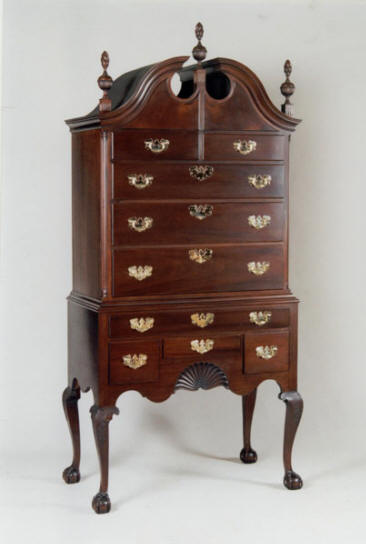
Townsend Bonnet-Top Highboy
with four ball & claw feet and shell
mahogany, 87"h, 39"w, 22½"d
From an original
authenticated to John Townsend, this highboy features his proportions
and construction methods with variations from the standard carved
details. The four ball and claw feet have open talons and strong
life-like knuckles. The knees feature unique foliate carving, and the
shell has a fleur-de-lis center rather than the more common palmette.
The upper case has fluted quarter columns and an open pediment
topped with three fluted urn-and-flame finials on fluted plinths.
The highboy has
hand-dovetailed upper and lower case construction and hand-dovetailed
drawers throughout. Like all other Newport highboys, the front is chosen
for consistent graining and the pediment panels are bookmatched from the
same stock.
similar examples: Moses p. 192,
Sack p. 197
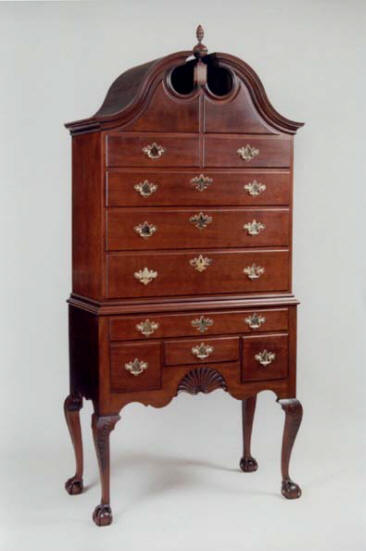
Goddard Bonnet-Top Highboy
with four ball & claw feet and shell
mahogany, 86"h, 40"w, 23"d
This highboy features the carved
detail indicative of the Goddard family workshop. It stands on four
open-talon ball and claw feet and has carved knees with a unique and
handsome foliate pattern. The incised shell has a scallop shell center
not seen on other Newport pieces. The open pediment has a central fluted
finial on a fluted plinth.
Like all Newport highboys, this example has
dovetailed upper and lower case construction and the drawers are fully
hand-dovetailed as well. Masterfully proportioned and carved, the
Goddard bonnet-top has a striking presence.
similar examples:
Moses p. 241, Heckscher p. 247
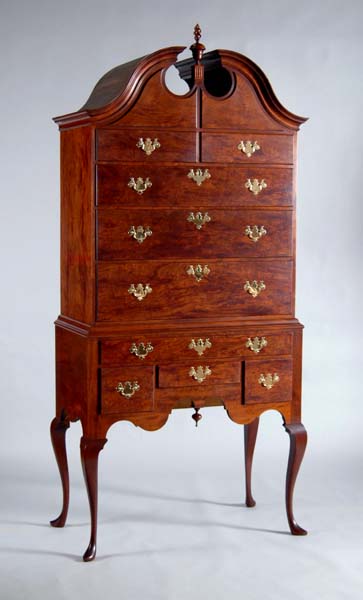
Newport Bonnet-Top Highboy
with slipper feet
mahogany, 87"h, 41"w, 21 1/2"d
After a Christopher or early John
Townsend original, this example illustrates that the essence of Newport
design is outstanding proportion combined with elegance of line. This
highboy begins with sculptural Townsend cabriole legs with slipper feet
supporting a base that uses a curved apron and single drop as its only
ornament. The upper case is similarly void of ornamental detail with the
exception of a single turned finial on a fluted plinth. The lack of
ornament allows the shape to be the predominant design element. The
legs, base apron, and open pediment successfully give the piece the
light, ethereal look sought after at the time it was made.
This example follows the Newport
standard of fully dovetailed upper and lower case construction, with
drawers dovetailed in the Townsend manner as well. It is a perfect
design to highlight well-figured wood.
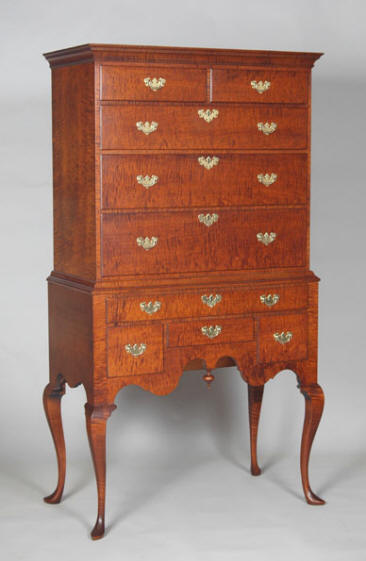
with slipper feet
figured maple, 73"h, 41"w, 21 1/2"d
Using the same proportions and construction as the previous Townsend bonnet-top highboy, this flat-top version was a choice for smaller rooms and more restrained tastes. It uses the same sweeping Townsend cabriole legs with slipper feet and a curved base apron with a central turned drop. The upper case has the same drawer arrangement and proportions, but with a flat top crowned by a bold molding.
The upper and lower cases are fully hand-dovetailed in the Newport tradition, and the drawers are hand-dovetailed in the same manner of the original Townsend makers.
This Newport flat-top highboy is shown in figured maple, but Newport makers also made them in mahogany and walnut for a more formal appearance.
similar example: Sack p.187
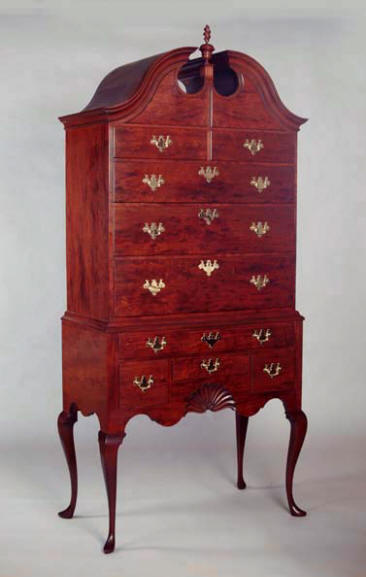
Newport Bonnet-top Highboy
with slipper feet and shell
mahogany, 87"h, 41"w, 21 1/2"d
A perfect example of the restrained use of ornament in Newport furniture, this highboy of Townsend design features a single shell in its base. The base stands on graceful cabriole legs ending in slipper feet. The shell incorporates a fleur-de-lis center (as seen in early John Townsend designs) and is integrated perfectly into the apron profile. The upper case has an open pediment and a central turned urn finial on a fluted plinth. On the whole, it's a striking composition that exudes elegance and grace as few other American highboys can.
This example follows the Newport tradition of fully dovetailed upper and lower case construction, with drawers dovetailed in the Townsend manner. It is a perfect design to pair with well-figured wood.
similar example: Sack p. 192
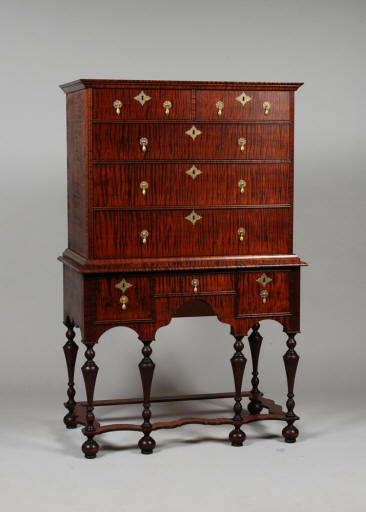
William and Mary Highboy
maple,
64"h, 40"w, 22"d
Highboys of the William and Mary
era are striking examples of early 18th-century American furniture
design. This is an early Boston highboy design with six trumpet-turned
legs, ball feet, and a base stretcher that mirrors the arches of the
apron shape. Double-arch moldings surround each drawer opening, and each
drawer is divided evenly by brass drop pulls and hand-chased keyhole
escutcheons.
The upper case and
all the drawers are fully hand-dovetailed, and the base is of pegged
mortise-and-tenon construction. This example is shown in figured maple,
but it is also offered in an ebonized finish and a fully japanned
surface (below).
similar example: Greene p. 56
